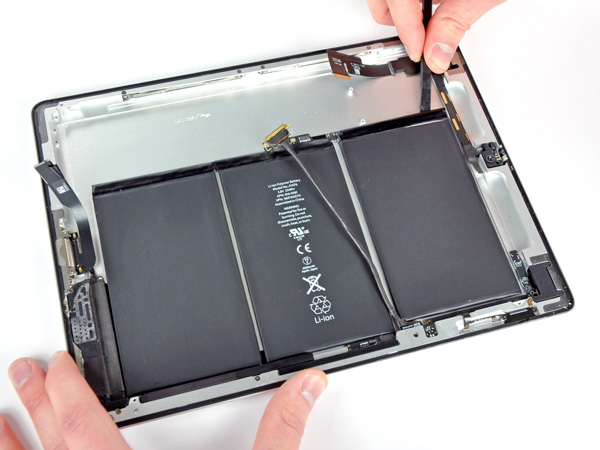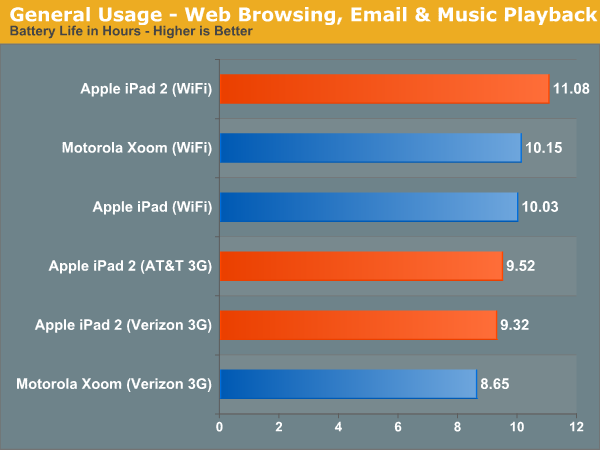The Apple iPad 2 Review
by Brian Klug, Anand Lal Shimpi & Vivek Gowri on March 19, 2011 8:01 PM ESTBattery Life
Testing battery life on a tablet is pretty grueling as these things are effectively smartphones with gigantic batteries. What would last for only a few hours on a smartphone can easily last over ten on a tablet. The iPad 2 is no exception.
As iFixit discovered, the iPad 2 features a nearly identical battery to the original iPad (25Wh vs. 24.8Wh). We already established that display brightness hasn't gone up so the only real impact on battery life will be because of the A5 SoC.

The iPad 2 WiFi's battery, courtesy iFixit
The ARM Cortex A9 tends to be more power efficient than its predecessor, the A8. With a shallower pipeline and the ability to execute instructions out of program order you get better performance per watt in most cases. As a result the A5 should complete bursts of instructions quicker than the A4 and get back to sleep sooner.
To put this to the test we put together a battery life test that combined our non-Flash smartphone web browsing test, checking for email every 15 minutes (via a Gmail account receiving ~100 emails per day) and constant local music playback while all of this is going on. The results are pretty much as expected:

Over WiFi the Motorola Xoom and iPad 1 deliver very similar results. The iPad 2 pulls ahead by around 8%, it's not a huge advantage but it's there. Over 3G there's a noticeable drop in battery life, putting both of the iPad 2s below 10 hours and kicking the Xoom down to under 9 hours. All of the numbers on this chart are respectable however and you can expect a good day's worth of use out of any of these tablets.
Note that while the iPad 2 did better than its predecessor if you were to run an app that pegged both CPU cores at 100% you'd see reduced battery life on the iPad 2 vs. the iPad 1. Granted you'd also see better performance on the iPad 2.
Video playback is obviously an important function of these new tablets so we put together a H.264 decode playback test as well. For this test we transcoded a copy of Quantum of Solace from a 1080p BD source down to a 720p H.264 using Handbrake's Normal encode profile with one modification. In order to enable smooth playback on the Motorola Xoom we had to disable b-frames in the encode. The results are below:

The iPad 2 consistently lasted longer than the original iPad in our video playback test. The Xoom however did noticeably worse. Unfortunately only a portion of the H.264 decode pipeline is accelerated by NVIDIA's Tegra 2 in this test. When playing back anything more strenuous, portions of the pipeline are handled by the CPU cores in software. If you were to enable b-frames the Xoom would not only stutter but its battery life would drop to around 6 hours.
On the iPad 2 its Cortex A9s are mostly powered down during this test, on the Xoom the A9s are helping with the heavy lifting for video decode and as a result we see lower battery life. Kal-El is expected to address this issue head on.










189 Comments
View All Comments
JarredWalton - Sunday, March 20, 2011 - link
Considering the source (ARMflix), you need to take that video with a huge grain of salt. It looks like they're running some Linux variant on the two systems (maybe Chromium?), and while the build may be the same, that doesn't mean it's optimized equally well for Atom vs. A9.Single-core Atom at 1.6GHz vs. dual-core A9 at 500MHz surfing the web is fine and all, but when we discuss Atom being faster than A9 we're talking about raw performance potential. A properly optimized web browser and OS experience with high-speed Internet should be good on just about any modern platform. Throw in some video playback as well, give us something more than a script of web pages in a browser, etc.
Now, none of this means ARM's A9 is bad, but to show that it's as fast as Atom when browsing some web pages is potentially meaningless. What we really need to know is what one platform can do well that the other can't handle properly. Where does A9 fall flat? Where does Atom stumble?
For me, right now, Atom sucks at anything video related. Sorry, but YouTube and Hulu are pretty important tools for me. That also means iOS has some concerns, as it doesn't support Flash at all, and there are enough places where Flash is still used that it creates issues. Luckily, I have plenty of other devices for accessing the web. In the end, I mostly play Angry Birds on my iPod Touch while I'm waiting for someone. :-)
Wilco1 - Sunday, March 20, 2011 - link
The article is indeed wrong to suggest that the A9 has only half the performance of an Atom. There are cases where a netbook with a single core Atom might be faster, for example if it runs at a much higher frequency, uses hyperthreading, and has a fast DDR3 memory system. However in terms of raw CPU performance the out-of-order A9 is significantly faster than the in-order Atom. Benchmark results such as CoreMark confirm this, a single core Atom cannot beat an A9 at the same frequency - even with hyperthreading. So it would be good to clarify that netbooks are faster because they use higher frequency CPUs and a faster memory system - as well as a larger battery...somata - Sunday, March 27, 2011 - link
CoreMark is nearly as meaningless as MIPS. Right now the best cross-platform benchmark we have is Geekbench. It uses portable, multi-threaded, native code to perform real tasks. My experience with Geekbench on the Mac/PC over the years indicates that Geekbench scores correlate pretty well to average application performance (determined by my personal suite of app benchmarks). Of course there will be outliers, but Geekbench does a pretty good job at representing typical code.Given that, the fact that a single-core 1.6GHz Atom (with HT) scores about 28% higher than the IPad's dual-core 1GHz A9s in the integer suite leaves me little doubt that the Atom, despite being in-order, has as good or better per-clock performance than the A9s.
Even the oft-maligned PowerPC G4 totally outclasses the dual A9s, with 43% better integer performance at 1.42GHz... and that's just with a single core competing against two!
tcool93 - Sunday, March 20, 2011 - link
Tablets do have their advantages despite what the article claims. For one thing, their battery life far out lives any Netbook or Notebook. They also run a lot cooler, unlike Notebooks and Netbooks, which you can fry an egg on. Maybe they aren't as portable as a phone, but who wants to look at the super tiny print on a phone.Tablets don't replace computers, and never will. There are nice to sit in bed with at night and browse the web or read books on, or play a simple game on. Anything that doesn't require a lot of typing.
Even a 10" tablet screen isn't real big to read text, but its MUCH easier to zoom in on text to read it with tablets. Unlike any Notebook/'Netbook, which its a huge pain to get to zoom in.
tcool93 - Sunday, March 20, 2011 - link
I do think the benchmarks shown here do show that there is quite an improvement over the Ipad 1, despite what many seem to claim that there isn't much of an upgrade.secretmanofagent - Sunday, March 20, 2011 - link
Anand,Appreciate the article, and appreciating that you're responding to the readers as well. All three of you said that it didn't integrate into your workflow, and I have a similar problem (which has prevented me from purchasing one). One thing I'm very curious about: What is your opinion on what would have been the Courier concept? Do you feel that is the direction that tablets should have taken, or do you think that Apple's refining as opposed to paradigming is the way to go?
VivekGowri - Sunday, March 20, 2011 - link
I still despise Microsoft for killing the Courier project. Honestly, I'd have loved to see the tablet market go that direction - a lot more focused on content creation instead of a very consumption-centric device like the iPad. A $4-500 device running that UI, an ARM processor, and OneNote syncing ability would have sold like hotcakes to students. If only...tipoo - Sunday, March 20, 2011 - link
Me too, the Courier looked amazing. They cancel that, yet go ahead with something like the Kin? Hard to imagine where their heads are at.Anand Lal Shimpi - Monday, March 21, 2011 - link
While I've seen the Courier video, and it definitely looked impressive, it's tough to say how that would've worked in practice.I feel like there are performance limitations that are at work here. Even though a pair of A9s are quick, they are by no means fast enough. I feel like as a result, evolutionary refinement is the only way to go about getting to where we need to be. Along the way Apple (and its competitors) can pick up early adopters to help fund the progress.
I'm really curious to see which company gets the gaming side of it down. Clearly that's a huge market.
Take care,
Anand
Azethoth - Monday, March 21, 2011 - link
Gaming side is a good question. Apple will have an advantage there due to limited hardware specs to code to. They are a lot more like a traditional console that way vs Android which will be anything but.Are actual game controls like in the psp phone necessary?
I am also curious what additional UI tech will eventually make it to the pad space:
* Speech, although it is forever not there yet.
* 3D maybe if its not a fad (glasses free)
* Some form of the Kinect maybe to manipulate the 3d stuff and do magical kinect gestures and incantations we haven't dreamed up yet.
* Haptic as mentioned earlier in the thread.
Speech could make a pad suitable for hip bloggers like the AnandTech posse.